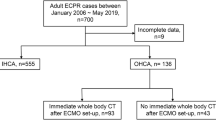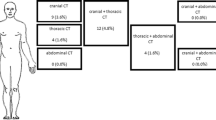Abstract
Purpose
Non-traumatic cardiac arrest (CA) and return of spontaneous circulation (ROSC) after cardiopulmonary resuscitation (CPR) are often associated with multiple pathologies. Expecting a high prevalence of important findings, a whole-body CT (WBCT) could be of relevance for therapy. The aim of this study is to investigate the feasibility and diagnostic yield of an early WBCT in this setting.
Methods
This single-center retrospective study included 100 consecutive patients (27 female; 73 male; mean age 68.5± 12.57 years) with non-traumatic, in- and out-of-hospital CA and ROSC following CPR, who underwent a contrast-enhanced WBCT within 6 h after ROSC over 12 months. CT findings were determined corresponding to anatomical region.
Results
Early WBCT was successfully carried out in 100% of the patients with CA and ROSC after CPR. Acute pathologies were found not only in the chest but also in the head (15%) and the abdomen (6%). Early global brain edema (n = 12), acute stroke (n = 3), pulmonary embolism (n = 10), pneumothorax (26%), acute abdominal pathologies (n = 6), iatrogenic bleeding (4%), and CPR-related injuries (93%) were detected by CT right from the beginning of the post-cardiac arrest care.
Conclusions
An early WBCT is feasible and provides added diagnostic value for patients with ROSC after non-traumatic CA.

Similar content being viewed by others
References
Hayashi M, Shimizu W, Albert CM (2015) The spectrum of epidemiology underlying sudden cardiac death. Circ Res 116:1887–1906. https://doi.org/10.1161/CIRCRESAHA.116.304521
Bergum D, Nordseth T, Mjølstad OC, Skogvoll E, Haugen BO (2015) Causes of in-hospital cardiac arrest - incidences and rate of recognition. Resuscitation 87:63–68. https://doi.org/10.1016/j.resuscitation.2014.11.007
Katritsis DG, Athens Euroclinic, Greece, and Beth Israel Deaconess Medical Center, Harvard Medical School, Boston, MA, USA, Gersh BJ et al (2016) A clinical perspective on sudden cardiac death. Arrhythmia & Electrophysiology Review 5:177. https://doi.org/10.15420/aer.2016:11:2
Dunham GM, Perez-Girbes A, Bolster F, Sheehan K, Linnau KF (2017) Use of whole body CT to detect patterns of CPR-related injuries after sudden cardiac arrest. Eur Radiol 33:39–36. https://doi.org/10.1007/s00330-017-5117-0
Jiang L, Ma Y, Jiang S et al (2014) Comparison of whole-body computed tomography vs selective radiological imaging on outcomes in major trauma patients: a meta-analysis. Scandinavian Journal of Trauma, Resuscitation and Emergency Medicine 22:54. https://doi.org/10.1186/s13049-014-0054-2
Callaway CW, Donnino MW, Fink EL, et al (2015) Part 8: post-cardiac arrest care: 2015 American Heart Association guidelines update for cardiopulmonary resuscitation and emergency cardiovascular care. Circulation. 132(suppl 2):S465–S482. https://doi.org/10.1161/CIR.0000000000000262
Nolan JP, Soar J, Cariou A, Cronberg T, Moulaert VRM, Deakin CD, Bottiger BW, Friberg H, Sunde K, Sandroni C (2015) European resuscitation council and European Society of Intensive Care Medicine 2015 guidelines for post-resuscitation care. Intensive Care Med 41:2039–2056. https://doi.org/10.1007/s00134-015-4051-3
Choi SJ, Kim HS, Kim EY, Choi HY, Cho J, Yang HJ, Kim YS (2014) Thoraco-abdominal CT examinations for evaluating cause of cardiac arrest and complications of chest compression in resuscitated patients. Emerg Radiol 21:485–490. https://doi.org/10.1007/s10140-014-1218-0
Kashiwagi Y, Sasakawa T, Tampo A, Kawata D, Nishiura T, Kokita N, Iwasaki H, Fujita S (2015) Computed tomography findings of complications resulting from cardiopulmonary resuscitation. Resuscitation 88:86–91. https://doi.org/10.1016/j.resuscitation.2014.12.022
Wijdicks EFM, Sheth KN, Carter BS, Greer DM, Kasner SE, Kimberly WT, Schwab S, Smith EE, Tamargo RJ, Wintermark M (2014) Recommendations for the management of cerebral and cerebellar infarction with swelling: a statement for healthcare professionals from the American Heart Association/American Stroke Association. Stroke 45:1222–1238. https://doi.org/10.1161/01.str.0000441965.15164.d6
Powers WJ, Rabinstein AA, Ackerson T, Adeoye OM, Bambakidis NC, Becker K, Biller J, Brown M, Demaerschalk BM, Hoh B, Jauch EC, Kidwell CS, Leslie-Mazwi TM, Ovbiagele B, Scott PA, Sheth KN, Southerland AM, Summers DV, Tirschwell DL, American Heart Association Stroke Council (2018) 2018 guidelines for the early management of patients with acute ischemic stroke: a guideline for healthcare professionals from the American Heart Association/American Stroke Association. Stroke 49:1–e110. https://doi.org/10.1161/STR.0000000000000158
Konstantinides SV, Torbicki A, Agnelli G et al (2014) 2014 ESC guidelines on the diagnosis and management of acute pulmonary embolism. Eur Heart J 35:3033–69–3069a–3069k. https://doi.org/10.1093/eurheartj/ehu283
Spahn DR, Bouillon B, Cerny V et al (2019) The European guideline on management of major bleeding and coagulopathy following trauma: fifth edition. Crit Care 23:74. https://doi.org/10.1186/s13054-019-2347-3
Doğan H, de Roos A, Geleijins J et al (2015) The role of computed tomography in the diagnosis of acute and chronic pulmonary embolism. Diagn Interv Radiol 21:307–316. https://doi.org/10.5152/dir.2015.14403
Aygun N, Masaryk TJ (2002) Diagnostic imaging for intracerebral hemorrhage. Neurosurg Clin N Am 13:313–34– vi
Sebastià C, Pallisa E, Quiroga S et al (1999) Aortic dissection: diagnosis and follow-up with helical CT. Radiographics 19:45–60– quiz 149–50. https://doi.org/10.1148/radiographics.19.1.g99ja0945
Lederer W, Mair D, Rabl W, Baubin M (2004) Frequency of rib and sternum fractures associated with out-of-hospital cardiopulmonary resuscitation is underestimated by conventional chest X-ray. Resuscitation 60:157–162. https://doi.org/10.1016/j.resuscitation.2003.10.003
Cho SH, Kim EY, Choi SJ, Kim YK, Sung YM, Choi HY, Cho J, Yang HJ (2013) Multidetector CT and radiographic findings of lung injuries secondary to cardiopulmonary resuscitation. Injury 44:1204–1207. https://doi.org/10.1016/j.injury.2012.10.004
Hoke RS, Chamberlain D (2004) Skeletal chest injuries secondary to cardiopulmonary resuscitation. Resuscitation 63:327–338. https://doi.org/10.1016/j.resuscitation.2004.05.019
Kim MJ, Park YS, Kim SW, Yoon YS, Lee KR, Lim TH, Lim H, Park HY, Park JM, Chung SP (2013) Chest injury following cardiopulmonary resuscitation: a prospective computed tomography evaluation. Resuscitation 84:361–364. https://doi.org/10.1016/j.resuscitation.2012.07.011
Kim EY, Yang HJ, Sung YM, Cho SH, Kim JH, Kim HS, Choi HY (2011) Multidetector CT findings of skeletal chest injuries secondary to cardiopulmonary resuscitation. Resuscitation 82:1285–1288. https://doi.org/10.1016/j.resuscitation.2011.05.023
Hellevuo H, Sainio M, Nevalainen R, Huhtala H, Olkkola KT, Tenhunen J, Hoppu S (2013) Deeper chest compression – more complications for cardiac arrest patients? Resuscitation 84:760–765. https://doi.org/10.1016/j.resuscitation.2013.02.015
Naples R, Ellison E, Brady WJ (2009) Cranial computed tomography in the resuscitated patient with cardiac arrest. Am J Emerg Med 27:63–67. https://doi.org/10.1016/j.ajem.2008.01.014
Scheel M, Storm C, Gentsch A et al (2013) The prognostic value of gray-white-matter ratio in cardiac arrest patients treated with hypothermia. Scandinavian Journal of Trauma, Resuscitation and Emergency Medicine 21:23. https://doi.org/10.1186/1757-7241-21-23
Lee YH, Oh YT, Ahn HC, Kim HS, Han SJ, Lee JJ, Lee TH, Seo JY, Shin DH, Ha SO, Park SO (2016) The prognostic value of the grey-to-white matter ratio in cardiac arrest patients treated with extracorporeal membrane oxygenation. Resuscitation 99:50–55. https://doi.org/10.1016/j.resuscitation.2015.11.009
Choi SP, Park HK, Park KN, Kim YM, Ahn KJ, Choi KH, Lee WJ, Jeong SK (2008) The density ratio of grey to white matter on computed tomography as an early predictor of vegetative state or death after cardiac arrest. Emerg Med J 25:666–669. https://doi.org/10.1136/emj.2007.053306
Metter RB, Rittenberger JC, Guyette FX, Callaway CW (2011) Association between a quantitative CT scan measure of brain edema and outcome after cardiac arrest. Resuscitation 82:1180–1185. https://doi.org/10.1016/j.resuscitation.2011.04.001
Lawes EG, Baskett PJ (1987) Pulmonary aspiration during unsuccessful cardiopulmonary resuscitation. Intensive Care Med 13:379–382
Oschatz E, Wunderbaldinger P, Sterz F, Holzer M, Kofler J, Slatin H, Janata K, Eisenburger P, Bankier AA, Laggner AN (2001) Cardiopulmonary resuscitation performed by bystanders does not increase adverse effects as assessed by chest radiography. Anesth Analg 93:128–133
Axelsson A, Herlitz J, Ekström L, Holmberg S (1996) Bystander-initiated cardiopulmonary resuscitation out-of-hospital. A first description of the bystanders and their experiences. Resuscitation 33:3–11
Franquet T, Giménez A, Rosón N, Torrubia S, Sabaté JM, Pérez C (2000) Aspiration diseases: findings, pitfalls, and differential diagnosis. Radiographics 20:673–685. https://doi.org/10.1148/radiographics.20.3.g00ma01673
Virkkunen I, Ryynänen S, Kujala S, Vuori A, Piilonen A, Kääriä JP, Kähärä V, Pettilä V, Yli-Hankala A, Silfvast T (2007) Incidence of regurgitation and pulmonary aspiration of gastric contents in survivors from out-of-hospital cardiac arrest. Acta Anaesthesiol Scand 51:202–205. https://doi.org/10.1111/j.1399-6576.2006.01229.x
Rossi A, Dharampal A, Wragg A, Davies LC, van Geuns RJ, Anagnostopoulos C, Klotz E, Kitslaar P, Broersen A, Mathur A, Nieman K, Hunink MGM, de Feyter PJ, Petersen SE, Pugliese F (2014) Diagnostic performance of hyperaemic myocardial blood flow index obtained by dynamic computed tomography: does it predict functionally significant coronary lesions? Eur Heart J Cardiovasc Imaging 15:85–94. https://doi.org/10.1093/ehjci/jet133
Machida H, Tanaka I, Fukui R, Shen Y, Ishikawa T, Tate E, Ueno E (2015) Current and novel imaging techniques in coronary CT. Radiographics 35:991–1010. https://doi.org/10.1148/rg.2015140181
Author information
Authors and Affiliations
Corresponding author
Ethics declarations
Conflict of interest
The authors declare that they have no conflict of interest.
Additional information
Publisher’s note
Springer Nature remains neutral with regard to jurisdictional claims in published maps and institutional affiliations.
Rights and permissions
About this article
Cite this article
Viniol, S., Thomas, R.P., König, A.M. et al. Early whole-body CT for treatment guidance in patients with return of spontaneous circulation after cardiac arrest. Emerg Radiol 27, 23–29 (2020). https://doi.org/10.1007/s10140-019-01723-x
Received:
Accepted:
Published:
Issue Date:
DOI: https://doi.org/10.1007/s10140-019-01723-x




